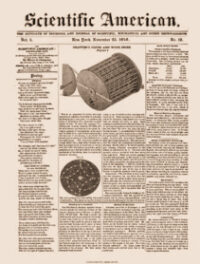April 6, 1861; The Scientific American
We take the following from the London Mechanics’ Magazine:
The first question for discussion is the comparative value of iron and wooden ships-of-war. In favor of the latter, we have a conservative party represented by Sir Howard Douglas, who is probably the ablest living advocate of “wooden walls.” It is his opinion “that ships formed wholly, or nearly so, of iron, are utterly unfit for all the purposes and contingencies of war, whether as fighting ships or as transports for troops.” In opposition to this opinion Mr. J. Scott Russell endeavors, and we think successfully, to establish :
1. That iron steamships-of-war may be built as strong as wooden ships of greater weight, and stronger than wooden ships of equal weight.
2. That iron ships of equal strength can go on less draught of water than wooden ships.
3. That iron ships can carry much heavier weights than wooden ships.
4. That they are more durable.
5. That they are safer against the sea.
6. That they are safer against fire.
7. That they are much safer against explosive shells.
8. That they are much safer against molten metal.
9. That they are much safer against red-hot shot.
10. That they can be made impregnable even against solid shot.
As Sir H. Douglas has attacked the construction and sailing qualities of the Great Eastern, his opponent first disproves his assertions and predictions regarding her, and then states the facts regarding iron war-ships which have been ascertained by actual experiment. Experience has proved, first, that “when the thickness of a vessel’s side is not more than half an inch, shots fired obliquely have glanced off the iron vessel which would have penetrated a wooden ship; second, that shots fired directly have passed through both sides of the ship, doing less damage to the ship directly and less damage by splinters than would have been the case in timber ships; third, that the shot holes have been as easily stopped, and more expeditiously and less expensively repaired than in wooden ships; fourth, that their plates of wrought-iron, even five-eighths of an inch, are proof against shells; that iron plates four inches and a half thick arc nearly impenetrable to shot fired from the heaviest nature of guns; and, finally, that plates six inches thick are practically impenetrable.”
